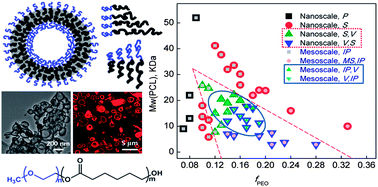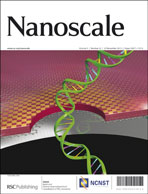Aqueous self-assembly of poly(ethylene oxide)-block-poly(ε-caprolactone) (PEO-b-PCL) copolymers: disparate diblock copolymer compositions give rise to nano- and meso-scale bilayered vesicles†
Abstract
Nanoparticles formed from diblock copolymers of FDA approved PEO and PCL have generated considerable interest as in vivo drug delivery vehicles. Herein, we report the synthesis of the most extensive family PEO-b-PCL copolymers that vary over the largest range of number-average molecular weights (Mn: 3.6–57k), PEO weight fractions (fPEO: 0.08–0.33), and PEO chain lengths (0.75–5.8k) reported to date. These polymers were synthesized in order to establish the full range of aqueous phase behaviours of these diblock copolymers and to specifically identify formulations that were able to generate bilayered vesicles (polymersomes). Cryogenic transmission electron microscopy (cryo-TEM) was utilized in order to visualize the morphology of these structures upon aqueous self-assembly of dry polymer films. Nanoscale polymersomes were formed from PEO-b-PCL copolymers over a wide range of PEO weight fractions (fPEO: 0.14–0.27) and PEO molecular weights (0.75–3.8k) after extrusion of aqueous suspensions. Comparative morphology diagrams, which describe the nature of self-assembled structures as a function of diblock copolymer molecular weight and PEO weight fraction, show that in contrast to micron-scale polymersomes, which form only from a limited range of PEO-b-PCL diblock copolymer compositions, a multiplicity of PEO-b-PCL diblock copolymer compositions are able to give rise to nanoscale vesicles. These data underscore that PEO-b-PCL compositions that spontaneously form micron-sized polymersomes, as well as those that have previously been reported to form polymersomes via a cosolvent fabrication system, provide only limited insights into the distribution of PEO-b-PCL diblocks that give rise to nanoscale vesicles. The broad range of polymersome-forming PEO-b-PCL compositions described herein suggest the ability to construct extensive families of nanoscale vesicles of varied bilayer thickness, providing the ability to tune the timescales of vesicle degradation and encapsulant release based on the intended in vivo application.


 Please wait while we load your content...
Please wait while we load your content...